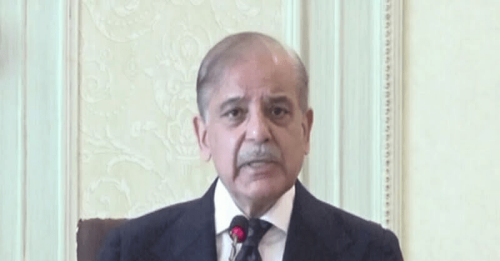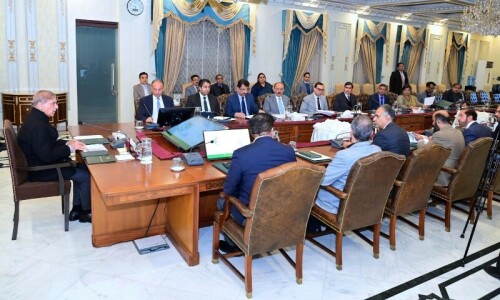FAMILIES find it harder to cover basic household expenses within their budgets. They experience a higher rate of inflation than the official rate of 4.5pc.
The corporate sector does not trust the declared data either, and assesses the annual rise in the cost of living independently for its own consumption.
The current inflation rate, for December 2014, is projected at an 11-year low. It is expected to be around 5.5pc for the current fiscal against the budgeted estimate of 8.5pc. The average rate for the last 55 years is 8.02pc. The all-time high rate was recorded at 37.8pc in 1973, and lowest at - 10pc in 1959. The Pakistan Bureau of Statistics (PBS) is vested with the responsibility of collecting the data and computing the inflation rate.
In its statement after easing monetary policy last week, the State Bank declared the low domestic inflation rate to be in line with the global trend. “The general deceleration in prices is linked to the oil price crash and the weakening of commodities prices. We do not see any reason to cast suspicion,” this was all a SBP source said. The bank draws on data to develop several indices, but has no role in its collection or processing, he added.
The corporate sector assessed the inflation rate at 14pc (against the official 8pc) for the last fiscal year, which it believed had decelerated by a little over 4pc, and currently borders near 10pc.
No business executive was ready to stick his neck out and own a statement on the subject. But the Overseas Investment Chamber of Commerce and Industry did confirm to Dawn that it does carry out an exercise to assess the rise in the annual cost of living for the benefit of its members.
“It is commissioned by our members who demand exclusivity and confidentiality, so the outcome of the exercise is not shared with the public,” OICCI secretary told this writer.
Experts believe that the government underreports the inflation rate. They raised questions about the base year, quality of data, collection practices, timeliness, weights in the price index, accuracy of price measurement, and relevance of inadequate income quintiles in the methodology used to calculate inflation. The changing spending pattern and the composition of family budgets had also not been accounted for in the formula.
The urban-rural divide, they felt, necessitates separate calculation of the inflation rate for the two sectors. They advised the government to revisit the formula of inflation twice a decade to insert necessary changes to keep it closer to reality.
The relevant government departments defended the 4.5pc rate as credible. The PBS, which constructs it, vouches that it acts independently, without any outside pressure to colour its findings. The officials took pride for systemising the process of collection and processing of the biggest database in the country.
Mohammad Zubair, chairman of the Privatisation Commission and a key member of Nawaz Sharif’s kitchen cabinet, was impressed by the quality of PBS’s presentations at the Economic Coordination Committee of the Cabinet (ECC). He believed that the inflation rate was worked out scientifically by a specialised team of statisticians.
“What can stop inflation from decelerating when fuel prices dropped by about 25pc over the past six months? Someone may contest the actual rate of the fall in inflation, but even that is preposterous in the absence of evidence. The southward trend is uncontestable. You may dislike the PML-N, but casting doubts on the intent and performance of an institution such as the PBS will hurt wider interests of the nation and not necessarily that of the ruling party,” Zubair said.
The higher ups in the PBS and the SBP were not able to present a satisfactory counterargument for some key points raised by the detractors.
For example, the base year was changed from 2001-02 to 2007-08, the year when the inflation was high at 17pc. The abrupt change in 2011, they believed, was motivated by politics. The earlier base years were 1990-91 and 2000-2001. The logical choice should have been 2010-11, or if the policymakers thought a 10-year interval was too long a period, they could have reduced it to five years. No plausible reason is available for the random choice of base year.
“It is not rocket science and is evident to anyone who cares to look through the machinations at the policy level. The same set of price data will throw up a lower rate when worked against the new base year of 2007-08 as compared to 2000-2001. The choice was made by the last government in 2011-12 to bring the rate down on paper,” an analyst said.
“The government has again decided to change the base year to 2015-16. It is a tedious exercise and we have already started working on it. No one at this point knows what the rate would be a year from now. So there is no point in reading too much into a decision on the base year,” a technocrat at the PBS said, trying to ward off the impression of changes being made to generate favourable economic indicators.
The problems were identified in comparative weights assigned to different categories of items. The weight of food in the price index is 37pc, when it is an established fact (confirmed by multiple World Bank studies) that the average Pakistani family spends over half of its family income on kitchen items.
Another issue is with the five income quintiles identified for the calculation of income group-wise inflation. The lowest income group covers families earning Rs8,000 per month, and the highest income group has been identified as the ones earning Rs35,000 and above. In between are groups with incomes of Rs8-12,000, Rs12-18,000 and Rs18-35,000.
The official minimum wage is currently Rs12,000, but a random survey by this scribe suggests an average poor family of six/seven people needs at least Rs25-28,000 for bare survival. If the family income is less than that, help is sought from the extended family or the community to meet the basic needs.
Meanwhile, higher-end families spend close to the total earning of the lowest income group on two family meals in upscale restaurants. “We know how rich the asset-owning class is in Pakistan; salaries of Rs300,000 for senior business executives and professionals is common. Putting the highest quintile at Rs35,000 and above is a joke.”
“Our data is derived from survey results. There is a possibility that people underreport their spending. We are not in the business of inventions, and depend on the outcome of surveys,” a senior member of the PBS team unconvincingly tried to defend the quintiles.
Published in Dawn, Economic & Business, February 2nd, 2015
On a mobile phone? Get the Dawn Mobile App: Apple Store | Google Play













































